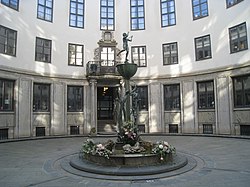You can help expand this article with text translated from
the corresponding article in Swedish. (March 2024) Click [show] for important translation instructions.
|
| Matchstick Palace | |
|---|---|
 Tändstickspalatset | |
|
| |
| General information | |
| Address | Västra Trädgårdsgatan 15 |
| Town or city | Stockholm |
| Country | Sweden |
| Coordinates | 59°19′54.59″N 18°4′10.42″E / 59.3318306°N 18.0695611°E |
| Completed | 1928 |
| Cost | 3,3 million SEK (1928) |
| Client | Swedish Match (Ivar Kreuger) |
| Design and construction | |
| Architect(s) | Ivar Tengbom |
The Matchstick Palace ( Swedish: Tändstickspalatset) is an office building on Västra Trädgårdsgatan in Stockholm, Sweden.
History
It was commissioned by the "Match King" Ivar Kreuger (1880–1932) as the headquarters of the Swedish match company Svenska Tändsticks AB. It was designed by architect Ivar Tengbom (1878-1968) and built by Kreuger & Toll Construction AB 1926–28. [1] [2] [3]
The palace remained Swedish Match's office until 1991 and was sold to Telia in 1999, who subsequently sold it to businessman Muhammed Al-Amoundi for SEK 450 million. Swedish Match moved their headquarter back to Tändstickspalatset, to one of the floors, 1 September 2010. The Matchstick Palace served as the headquarters for Swedish Match at the beginning of the 1930s, 1972–1991, and 2010–2015. [4] [5] [6] [7] [8][ failed verification]
Description
Behind the latticework and Corinthian columns of the main portico is the horseshoe-shaped inner courtyard on which the building is centered. The façades of the ground floor are dressed in marble from Kolmården and the courtyard is furnished with the sculpture Diana fountain I by sculptor Carl Milles (1875–1955). [9]
Inside the portico are two flights of stairs leading up to the quarters of the board of directors, where is the circle segment-shaped board meeting room with paintings by expressionist painter Isaac Grünewald (1889–1946). [10]
On the opposite side of the courtyard, the first two floors are taken up by the session room. The space between the building and the park was kept void until the 1970s. [11]

Gallery
-
Entrance of Matchstick Palace
-
Balcony with view over the inner yard.
-
Sculpture Diana fountain I
by Carl Milles. -
Exterior of Matchstick Palace
References
- ^ "Svenska Tändsticks AB". Nederlight BV. Retrieved August 1, 2020.
- ^ "Ivar Kreuger, the match king". The Economist. Retrieved August 1, 2020.
- ^ "Tengbom, Ivar (1878 - 1968)". KulturNav. Retrieved August 1, 2020.
- ^ Stugart, Martin (2006-02-02). "Vad kan du berätta om Tändstickspalatset?" (in Swedish). Dagens Nyheter. Archived from the original on 1 October 2007. Retrieved 2008-02-02.
- ^ "Tändstickspalatset sålt". Fastighetsvärlden (in Swedish). 3 November 1999. Retrieved 11 August 2017.
- ^ "Swedish Match flyttar åter till Tändstickspalatset" (in Swedish). Midroc Real Estate AB. 2010-01-28. Archived from the original on 14 May 2014. Retrieved 2014-05-13.
- ^ "Swedish Match Company History". Swedish Match. 2013-10-17. Archived from the original on 13 November 2013. Retrieved 2014-05-13.
- ^ Andersson, Klas (7 April 2014). "Swedish Match flyttar huvudkontoret". Svenska Dagbladet (in Swedish). Retrieved 10 August 2017.
- ^ "W Carl E Milles". Svenskt biografiskt lexikon. Retrieved August 1, 2020.
- ^ "Isaac H Grünewald". Svenskt biografiskt lexikon. Retrieved August 1, 2020.
- ^ Johansson, Bengt O H (1999). "Norra innerstaden". Guide till Stockholms arkitektur (2nd ed.). Stockholm: Arkitektur Förlag AB. p. 68. ISBN 91-86050-41-9.



